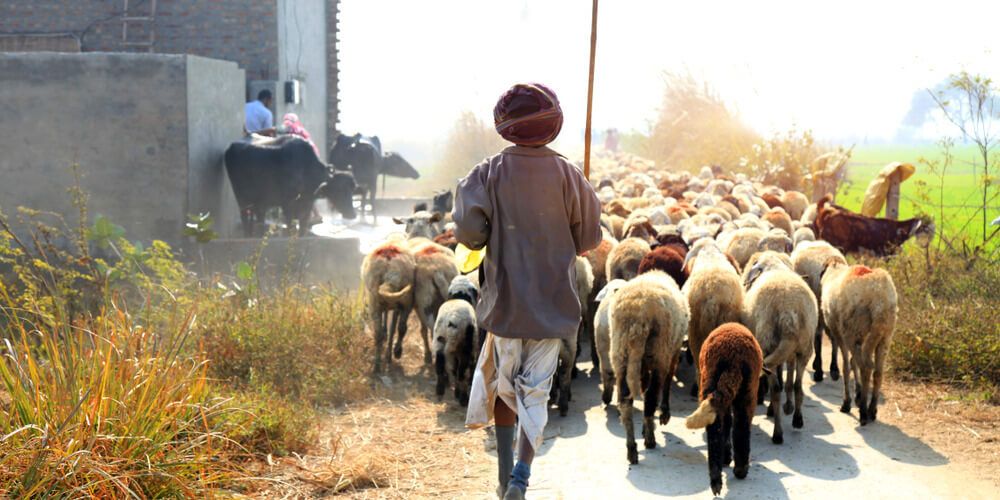
India has huge potential as halal meat export source
High quality meat sees growing exports to the Gulf States.
New Delhi: While 80% of India’s 1.4 billion people may be Hindu, the prominent position of Muslims in the country’s slaughtering and butchery sector means it has vast potential as a halal meat and meat products supplier to the Islamic world, say experts.
Only in slaughterhouses serving Sikh areas – there are more than 20 million Sikhs in India, mainly living in the Punjab – is non-halal slaughtering commonplace. The Sikh community prefers animals be slaughtered by the jhatka technique where the head is severed in one stroke by a sharp tool.
However, according to Aswhani Kumar Rajput, executive director of All India Poultry Breeders Association, only 5% of Indian animals and birds are slaughtered by this method with most of the rest being halal.
“There are some slaughterhouses where non-halal meat is also processed, mainly to supply the Sikh regiment of the Indian army. During that time normal halal production is stopped,” said Maulana Niaz Ahmed Farooqui, chief executive of Jamiat Ulama-i-Hind Halal Trust, a major halal certifying agency based in the capital New Delhi.
Mohammad Yusuf Qureshi, Uttar Pradesh (UP) state president of All India Jamaat-ul-Quraish, a meat traders’ association, told Salaam Gateway: “All the slaughtermen, especially in UP, are Muslim and there is no doubt the meat will be halal.”
The UP towns of Unnao, Aligarh and Ghaziabad are the major slaughtering centres for buffalo meat, said Farooqui.
UP is India’s most populous state with more than 205 million people, 20% of whom are Muslim. It is also an important one for meat exports, housing nine of the country’s 12 meat processing plants approved by the central government’s Agricultural and Processed Food Products Export Development Authority (APEDA).
The other three are in west India’s Maharashtra and southern India’s Karnataka. In all there are about 3,600 slaughterhouses in the country, according to APEDA figures.
According to a central government survey, the majority of Indian Hindus eat meat and are not concerned if it is halal or not. Hence, the potential for exporting halal meat from India was significant and realised.
|
Read - Vegetarianism and Islamophobia hinders halal growth in India Read - Muslim women in India face huge job market discrimination |
Meat and offal exports grew 4.76% last financial year
According to figures released by Indian ministry of commerce and industry, in the financial year ending March 2022, the country exported $3.38 billion worth of meat and edible offal, 4.76% higher than the previous year.
The biggest destinations were majority Muslim Egypt ($740 million) and Malaysia ($445 million) as well as Vietnam ($488 million). Meanwhile, to wealthy Muslim markets such as the United Arab Emirates (UAE) and Saudi Arabia, exports were $164 million and $159 million respectively, registering a year-on-year growth of 33% and 45%.
Other export markets were Oman ($44 million), Qatar ($31 million) and Kuwait and Bahrain ($25 million each).
The Jamiat Ulama-i-Hind Halal Trust, which Farooqui said is accredited by 13 countries including Saudi Arabia and UAE, provides 200 contracted halal supervisors to certified Indian slaughterhouses. They ensure the slaughtering knife is sharp; animals are not tortured; they are served water and the slaughtermen recite “Bismillah, Allah Hu Akbar” as they kill livestock.
Farooqui said using such supervisors was commonplace in Indian slaughterhouses that require halal certification (including exporters), with often at least two – and sometimes four – people on duty when slaughtering takes place.
India’s competitive advantage was not just its compliance with ritual. Farooqui said the quality of the country’s buffalo meat was the best; its taste good and it has high protein and low-fat content.
He emphasised Indian halal standards were strict and its certifying system highly organised.
India enjoys a major cost advantage over other exporters like Brazil and Australia in the buffalo segment as a significant proportion of the Indian meat comes from spent animals mainly reared for milk, said Rajput, also executive director of All India Poultry Breeders Association.
He said the same applied to Indian goats and sheep. These products experience high demand with two to three cargo planes departing Delhi Airport daily for the Gulf countries.
“Further butchering of these carcasses is done in the Gulf countries itself,” he said.
However, unfortunately Indian broiler chickens were raised exclusively for their meat. Brazil, as a major chicken exporter, has a lower cost of production meaning India does not export many chickens.
Regardless, the Indian meat industry is large
According to the last livestock census conducted by the central government’s department of animal husbandry and dairying in 2019, there were 110 million buffaloes, 74 million sheep, 149 million goats and 852 million poultry birds in India.
These quantities were significantly higher than the 2012 census. The number of cows also increased to 145 million but, as Hindus consider them holy, their slaughter and consumption is banned in most Indian states including UP.
The southern state of Kerala, with its significant Muslim and Christian populations, does allow cows to be slaughtered. As well as offering beef for local consumption – although not for exports, which cannot be made from India – this state’s strong meat sector also supplies many butchers and slaughterhouse workers (along with mainly Hindu neighbouring Tamil Nadu) to export-oriented slaughterhouses in UP. These are often contracted labourers and include many women, said Farooqui.
Slaughterhouse owners provide their workers with shared in-house accommodation, some of which consist of 50 to 100 residential quarters, and operate in two eight-hour shifts daily, said Qureshi, whose brother owns one such slaughterhouse in UP.
These southern slaughtering skills are in demand as UP businesses can struggle to hire local slaughterers with good hygiene practice, he said.
Quality matters in the export business and operations are scrutinised by teams from buyers’ companies making regular inspection visits; checking for dust, pests and even cats, said Qureshi.
“If there is any hair, fly or mosquito found in the meat, everything is rejected and wasted,” he said.
Combining such skills, with halal awareness and large volumes, the Indian meat sector is set to be a major meat supplier to the Muslim world for years to come.
© SalaamGateway.com 2022. All Rights Reserved

Raghavendra Verma